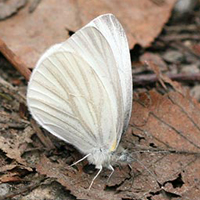What You Need to Know About the West Virginia White Butterfly: Species at Risk series
Did you know butterflies are critical pollinators for our plants and crops? These small invertebrates aren’t just stunning, they play a crucial role in our ecosystem.
But over the last four decades, we’ve seen over 450 butterfly species decline at an average rate of almost two per cent a year.
In Canada, our iconic Monarch butterfly has declined by over 80 per cent in the last two decades in eastern regions. The western population dropped by 99 per cent in nearly three decades.
Today, we’re highlighting a lesser-known Canadian butterfly: the West Virginia White, or Pieris virginiensis.
The West Virginia White is listed as special concern in Ontario. This means it’s not endangered or threatened but may become so due to biological characteristics and identified threats.

What do they look like?
This butterfly is remarkably small with a three-to-four-centimetre wingspan. Its colouring is almost completely white, though its veins have a grey-brown tone to them. The West Virginia White’s wings look almost translucent.
In its caterpillar stage, the West Virginia White is a yellow-green colour with a striking green stripe on each side.
Where do they live?
The West Virginia White butterfly prefers moist, deciduous wooded areas. West Virginia Whites need a steady supply of toothwort, a spring-blooming plant, to eat in its larvae stage.
This woodland butterfly can be found in central and southern Ontario, as well as southern Quebec. It’s most densely populated along the western Lake Ontario region.
What threatens their survival?
The West Virginia White needs safe, woodland areas to live. Unfortunately, habitat fragmentation due to urban development and logging has led to the loss of some of these sites.
Garlic mustard, an invasive species in Ontario, is also a major cause of concern for this butterfly. Although garlic mustard is related to toothwort, the West Virginia White doesn’t feed on the plant. However, they sometimes lay their eggs on it, but the larvae don’t eat the garlic mustard and, as a result, unfortunately don’t survive to the caterpillar stage.
What are we doing to help?
The West Virginia White, like all butterflies, are pollinators. They play a key role in the survival of Ontario’s plants, particularly those that are rare or at risk. Our work to protect Ottawa Valley’s public lands will help safeguard the wooded areas these butterflies call home.
Sign up for our newsletter to stay informed about our work and how you can help protect species at risk.
